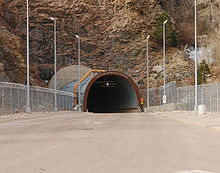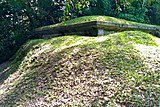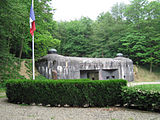Bunker

The north entrance to the Cheyenne Mountain Complex in Colorado, USA
A bunker is a defensive military fortification designed to protect people or valued materials from falling bombs or other attacks. Bunkers are mostly underground, compared to blockhouses which are mostly above ground.[1] They were used extensively in World War I, World War II, and the Cold War for weapons facilities, command and control centers, and storage facilities (for example, in the event of nuclear war). Bunkers can also be used as protection from tornadoes.
Trench bunkers are small concrete structures, partly dug into the ground. Many artillery installations, especially for coastal artillery, have historically been protected by extensive bunker systems. Typical industrial bunkers include mining sites, food storage areas, dumps for materials, data storage, and sometimes living quarters. When a house is purpose-built with a bunker, the normal location is a reinforced below-ground bathroom with fibre-reinforced plastic shells. Bunkers deflect the blast wave from nearby explosions to prevent ear and internal injuries to people sheltering in the bunker. Nuclear bunkers must also cope with the underpressure that lasts for several seconds after the shock wave passes, and block radiation.
A bunker's door must be at least as strong as the walls. In bunkers inhabited for prolonged periods, large amounts of ventilation or air conditioning must be provided. Bunkers can be destroyed with powerful explosives and bunker-busting warheads.
Contents
1 Etymology
2 Types
2.1 Trench
2.2 Artillery
2.3 Industrial
2.4 Personal
2.5 Munitions storage
3 Design
3.1 Blast protection
3.2 Nuclear protection
3.3 General features
4 Countermeasures
5 Famous installations
6 See also
7 Notes
8 References
9 External links
Etymology
The word bunker originates as a Scots word for "bench, seat" (recorded 1758, alongside shortened bunk "sleeping berth").[2] The word possibly has a Scandinavian origin: Old Swedish bunke means "boards used to protect the cargo of a ship".[3]
In the 19th century the word came to describe a coal store (typically below ground) in a house, or (below decks) in a ship. It was also used for a sand-filled depression installed on a golf course as a hazard.[4]
In the First World War as the belligerents built underground shelters (called dugouts in English) the Germans used the term bunker:[5][6] By the Second World War the term came to be used by the Germans to describe permanent structures both large (Eng: "blockhouse") and small ("pillbox"), and to bombproof shelters both above ground (as in Hochbunker) and below ground (such as the Führerbunker).[7]
The military sense of the word was imported into English during World War II, at first in reference to specifically German dug-outs; according to the Oxford English Dictionary, the sense of "military dug-out; a reinforced concrete shelter" is first recorded on 13 October 1939, in "A Nazi field gun hidden in a cemented 'bunker' on the Western front".[8] All the early references to its usage in the Oxford English Dictionary are to German fortifications.
However in the Far East the term was also applied to the earth and log positions built by the Japanese, the term appearing in a 1943 instruction manual issued by the British Indian Army and quickly gaining wide currency.[9]
By 1947 the word was familiar enough in English that Hugh Trevor-Roper in The Last Days of Hitler was describing Hitler's underground complex near the Reich Chancellery as "Hitler's own bunker" without quotes around the word bunker.[8]
Types
Trench
This type of bunker is a small concrete structure, partly dug into the ground, which is usually a part of a trench system. Such bunkers give the defending soldiers better protection than the open trench and also include top protection against aerial attack (grenades, mortar shells). They also provide shelter against the weather. Some bunkers may have (partially) open tops to allow weapons to be discharged with the muzzle pointing upwards (e.g. mortars and anti-aircraft weapons).[10]
The front bunker of a trench system usually includes machine guns or mortars and forms a dominant shooting post. The rear bunkers are usually used as command posts or Tactical Operations Centers (TOCs), for storage and as field hospitals to attend to wounded soldiers.
Artillery
Many artillery installations, especially for coastal artillery, have historically been protected by extensive bunker systems. These usually housed the crews serving the weapons, protected the ammunition against counter-battery fire, and in numerous examples also protected the guns themselves, though this was usually a trade-off reducing their fields of fire. Artillery bunkers are some of the largest individual pre-Cold War bunkers. The walls of the 'Batterie Todt' gun installation in northern France were up to 3.5 m thick,[11] and an underground bunker was constructed for the V-3 cannon.
Converted Mines/Caves for WWII Industrial Bunkers
- Ebensee
- Hinterbrühl
- Lager Rebstock
- Mittelwerk
- Saint Leu d'Esserent
- Marnate's Bunker
Industrial
Typical industrial bunkers include mining sites, food storage areas, dumps for materials, data storage, and sometimes living quarters. They were built mainly by nations like Germany during World War II to protect important industries from aerial bombardment. Industrial bunkers are also built for control rooms of dangerous activities, e.g. tests of rocket engines or explosive experiments. They are also built in order to perform dangerous experiments in them or to store radioactive or explosive goods. Such bunkers also exist on non-military facilities.
Personal
When a house is purpose-built with a bunker, the normal location is a reinforced below-ground bathroom with large cabinets[citation needed]. One common design approach uses fibre-reinforced plastic shells. Compressive protection may be provided by inexpensive earth arching[citation needed]. The overburden is designed to shield from radiation.[citation needed] To prevent the shelter from floating to the surface in high groundwater, some designs have a skirt held-down with the overburden.[12] It may also serve the purpose of a safe room[citation needed].
Munitions storage
Munitions storage bunkers are designed to securely store explosive ordnance, and contain any internal explosions. The most common configuration for high explosives storage is the igloo shaped bunker. They are often built into a hillside in order to provide additional containment mass.
A specialized version of the munitions bunker called a Gravel Gertie is designed to contain radioactive debris from an explosive accident while assembling or disassembling nuclear warheads. They are installed at all facilities in the US and UK which do warhead assembly/disassembly, the largest being the Pantex plant in Amarillo, TX, which has 12 Gravel Gerties.
Design

Inside the Hill 60 Bunker, Port Kembla, New South Wales. One of many bunkers south of Sydney

In a Project 131 tunnel under the hills of Hubei
Object 17/5001 Prenden Germany

Beach bunker with improvised art in Blåvand, Denmark

Bunker in Singapore

The entrance to Ouvrage Schoenenbourg along the Maginot Line in France.

Bunkers in Albania
German single person bunker for reconnaissance personnel in the field

Bunker of type Winkel in Brandenburg an der Havel

Munitions bunker at Possum Park, Queensland.

Gravel Gertie at the Pantex nuclear weapons plant, Amarillo TX.

Austrian bunker from World War I in West Ukraine
Blast protection
Bunkers deflect the blast wave from nearby explosions to prevent ear and internal injuries to people sheltering in the bunker. While frame buildings collapse from as little as 3 psi (0.2 bar) of overpressure, bunkers are regularly constructed to survive several hundred psi (over 10 bar). This substantially decreases the likelihood that a bomb (other than a bunker buster) can harm the structure.
The basic plan is to provide a structure that is very strong in physical compression. The most common purpose-built structure is a buried, steel reinforced concrete vault or arch. Most expedient (makeshift) blast shelters are civil engineering structures that contain large buried tubes or pipes such as sewage or rapid transit tunnels. Improvised purpose-built blast shelters normally use earthen arches or vaults. To form these, a narrow (1-2 meter) flexible tent of thin wood is placed in a deep trench (usually the apex is below grade), and then covered with cloth or plastic, and then covered with 1–2 meter of tamped earth.
A large ground shock can move the walls of a bunker several centimeters in a few milliseconds. Bunkers designed for large ground shocks must have sprung internal buildings to protect inhabitants from the walls and floors.[13]
Nuclear protection
Nuclear bunkers must also cope with the underpressure that lasts for several seconds after the shock wave passes, and block radiation. Usually these features are easy to provide. The overburden (soil) and structure provide substantial radiation shielding, and the negative pressure is usually only 1/3 of the overpressure.
General features

A bunker on the island of Texel, in the Netherlands.
The doors must be at least as strong as the walls. The usual design is now starting to incorporate vault doors. To reduce the weight, the door is normally constructed of steel, with a fitted steel lintel and frame. Very thick wood also serves, and is more resistant to heat because it chars rather than melts.[citation needed] If the door is on the surface and will be exposed to the blast wave, the edge of the door is normally counter-sunk in the frame so that the blast wave or a reflection cannot lift the edge. A bunker should have two doors. Door shafts may double as ventilation shafts to reduce digging.
In bunkers inhabited for prolonged periods, large amounts of ventilation or air conditioning must be provided in order to prevent ill effects of heat. In bunkers designed for war-time use, manually operated ventilators must be provided because supplies of electricity or gas are unreliable. One of the most efficient manual ventilator designs is the Kearny Air Pump. Ventilation openings in a bunker must be protected by blast valves. A blast valve is closed by a shock wave, but otherwise remains open. One form of expedient blast valve is worn flat rubber tire treads nailed or bolted to frames strong enough to resist the maximum overpressure.[14]
If a bunker is in a built-up area, it may have to include water-cooling or an immersion tub and breathing tubes to protect inhabitants from fire storms.
Bunkers must also protect the inhabitants from normal weather, including rain, summer heat and winter cold. A normal form of rainproofing is to place plastic film on the bunker's main structure before burying it. Thick (5-mil or 0.13 mm), inexpensive polyethylene film serves quite well, because the overburden protects it from degradation by wind and sunlight.
Countermeasures
Bunkers can be destroyed with powerful explosives and bunkerbusting warheads. The crew of a pillbox can be killed with flamethrowers.[15] Complex, well-built and well-protected fortifications are often vulnerable to attacks on access points. If the exits to the surface can be closed off, those manning the facility can be trapped. The fortification can then be bypassed.
Famous installations
Famous bunkers include the post-World War I Maginot Line on the French eastern border and Czechoslovak border fortifications mainly on the northern Czech border facing Germany (but to lesser extent all around), Fort Eben-Emael in Belgium, Alpine Wall on the north of Italy, World War II Führerbunker and in Italy, industrial Marnate's Bunker, the V-weapon installations in Germany (Mittelwerk) & France (e.g. La Coupole, and the Blockhaus d'Éperlecques) and the Cold War installations in the United States (Cheyenne Mountain Complex, Site R, and The Greenbrier), United Kingdom (Burlington), Sweden (Boden Fortress) and Canada (Diefenbunker). In Switzerland, there is an unusually large number of bunkers because of a law requiring protective shelters to be constructed for all new buildings since 1963, as well as a number of bunkers built as part of its National Redoubt military defense plan. Some of Switzerland's bunkers have since become tourist attractions housing hotels and museums such as Sasso San Gottardo Museum.[16]
The Soviet Union maintained huge bunkers (one of the secondary uses of the very deeply dug Moscow Metro and Kyiv metro systems was as nuclear shelters). A number of facilities were constructed in China, such as Beijing's Underground City and Underground Project 131 in Hubei; in Albania, Enver Hoxha dotted the country with hundreds of thousands of bunkers.
See also
- Air-raid shelter
- Fallout shelter
- Pillbox (military)
- Regelbau
- Continuity of government
Notes
^ For the difference between bunkers and blockhouses see Schneider & Kitchen 2002, p. 87, BACM Research 2009, p. 263, Davis 2007, p. 290
^ "Archived copy". Archived from the original on 16 November 2016. Retrieved 16 November 2016.CS1 maint: Archived copy as title (link) .mw-parser-output cite.citationfont-style:inherit.mw-parser-output qquotes:"""""""'""'".mw-parser-output code.cs1-codecolor:inherit;background:inherit;border:inherit;padding:inherit.mw-parser-output .cs1-lock-free abackground:url("//upload.wikimedia.org/wikipedia/commons/thumb/6/65/Lock-green.svg/9px-Lock-green.svg.png")no-repeat;background-position:right .1em center.mw-parser-output .cs1-lock-limited a,.mw-parser-output .cs1-lock-registration abackground:url("//upload.wikimedia.org/wikipedia/commons/thumb/d/d6/Lock-gray-alt-2.svg/9px-Lock-gray-alt-2.svg.png")no-repeat;background-position:right .1em center.mw-parser-output .cs1-lock-subscription abackground:url("//upload.wikimedia.org/wikipedia/commons/thumb/a/aa/Lock-red-alt-2.svg/9px-Lock-red-alt-2.svg.png")no-repeat;background-position:right .1em center.mw-parser-output .cs1-subscription,.mw-parser-output .cs1-registrationcolor:#555.mw-parser-output .cs1-subscription span,.mw-parser-output .cs1-registration spanborder-bottom:1px dotted;cursor:help.mw-parser-output .cs1-hidden-errordisplay:none;font-size:100%.mw-parser-output .cs1-visible-errorfont-size:100%.mw-parser-output .cs1-subscription,.mw-parser-output .cs1-registration,.mw-parser-output .cs1-formatfont-size:95%.mw-parser-output .cs1-kern-left,.mw-parser-output .cs1-kern-wl-leftpadding-left:0.2em.mw-parser-output .cs1-kern-right,.mw-parser-output .cs1-kern-wl-rightpadding-right:0.2em Online Etymology Dictionary
^ Fascinating Facts From the World of Golf
^ Bunker at Oxford English Dictionary; retrieved 9 August 2018
^ Harry Horstmann, Der Soldat: In Sprache und Tradition (2010), p. 153.
^ "Archived copy". Archived from the original on 16 November 2016. Retrieved 16 November 2016.CS1 maint: Archived copy as title (link) Das Wortauskunftssystem zur deutschen Sprache in Geschichte und Gegenwart
^ "The German term Bunker was used to denote a type of shelter which was of permanent construction. It can be distinguished from the improvised type built in cellars or by reinforcing ordinary buildings. Bunkers were of two types: underground and tower" (Morale Division (1945). The effect of bombing on health and medical care in Germany. Reports: European war, United States Strategic Bombing Survey. 65 (2 ed.). United States War Department. p. 189 (footnote "*").)
^ ab War Pictorial, cited after "bunker, n.1.c". Oxford English Dictionary (Second ed.). Oxford University Press. December 2011 [1989].
(subscription required)
^ Tim Moreman The Jungle, Japanese and the British Commonwealth Armies at War 1941-45 p98 (2013) Routledge
ISBN 9781135764555
^ An archival look at World War I Archived 19 December 2008 at the Wayback Machine. from the Queen's University Archives, Kingston, Ontario, Canada. Accessed 2008-02-10
^ "Accueil". Muse du Mur de l'Atlantique d'Audinghen website. Archived from the original on 10 January 2008. Retrieved 10 February 2008.
^ Kearny, Cresson H (1987). Nuclear War Survival Skills. Oak Ridge National Laboratory. ISBN 0-942487-01-X. Retrieved 2008-06-19.
NOTE: Kearny recommends stockpiling materials for a blast or fallout shelter and constructing it only if war appears very likely.
^ "Bunker Thoughts". prepare-and-protect.net. 25 January 2014. Archived from the original on 30 September 2017. Retrieved 2 May 2018.
^ "App. D: Expedient Blast Shelters". Arnold Jagt. Archived from the original on 25 May 2011. Retrieved 10 June 2010.
^ Flame Thrower Archived 17 September 2017 at the Wayback Machine.
^ Nalewicki, Jennifer (23 March 2016). "Switzerland's Historic Bunkers Get a New Lease on Life". The Smithsonian. Retrieved 4 April 2016.
References
BACM Research (2009), Vietnam War After Action Reports, BACM Research, p. 263
Davis, Tracy C. (2007), Stages of emergency: Cold War nuclear civil defense (illustrated ed.), Duke University Press, p. 290, ISBN 978-0-8223-3970-0
Schneider, Richard Harold; Kitchen, Ted (2002), Planning for crime prevention: a transatlantic perspective, RTPI library series, 3 (illustrated ed.), Routledge, p. 87, ISBN 978-0-415-24136-6
External links
| Look up bunker in Wiktionary, the free dictionary. |
| Wikimedia Commons has media related to Bunker. |
BunkerBlog: All about German fortifications 1933-1945
Bunkersite.com: About bunkers built by the Germans during 1933-1945 in the whole of Europe
German bunkers in Poland: Fortified Front Odra-Warta rivers, Boryszyn Loop












